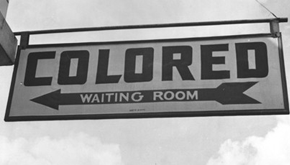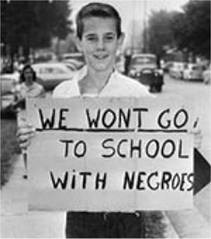
Good Morning POU!
Today we take a look at the history of Jim Crow laws.
Jim Crow laws were a collection of state and local statutes that legalized racial segregation. Named after an insulting song lyric regarding African Americans, the laws—which existed for about 100 years, from the post-Civil War era until 1968—were meant to return Southern states to an antebellum class structure by marginalizing black Americans. Black communities and individuals that attempted to defy Jim Crow laws often met with violence and death.

The phrase “Jim Crow Law” can be found as early as 1892 in the title of a New York Times article about Louisiana requiring segregated railroad cars. The origin of the phrase “Jim Crow” has often been attributed to “Jump Jim Crow“, a song-and-dance caricature of blacks performed by white actor Thomas D. Rice in blackface.
The roots of Jim Crow laws began as early as 1865, immediately following the ratification of the 13th Amendment freeing four million slaves.
Black codes were strict laws detailing when, where and how freed slaves could work, and for how much compensation. The codes appeared throughout the South as a legal way to put black citizens into indentured servitude, to take voting rights away, to control where they lived and how they traveled and to seize children for labor purposes.
The legal system was stacked against black citizens, with ex-Confederate soldiers working as police and judges, making it difficult for African Americans to win court cases and ensuring they became victim to the black codes.

Jim Crow laws—sometimes, as in Florida, were part of state constitutions—mandating the segregation of public schools, public places, and public transportation, and the segregation of restrooms, restaurants, and drinking fountains for whites and blacks. The U.S. military was already segregated. President Woodrow Wilson, a Southern Democrat, initiated segregation of federal workplaces in 1913.
Between 1890 and 1910, ten of the eleven former Confederate states, starting with Mississippi, passed new constitutions or amendments that effectively disenfranchised most blacks and tens of thousands of poor whites through a combination of poll taxes, literacy and comprehension tests, and residency and record-keeping requirements. Grandfather clauses temporarily permitted some illiterate whites to vote but gave no relief to most blacks.

Voter turnout dropped drastically through the South as a result of such measures. In Louisiana, by 1900, black voters were reduced to 5,320 on the rolls, although they comprised the majority of the state’s population. By 1910, only 730 blacks were registered, less than 0.5% of eligible black men. “In 27 of the state’s 60 parishes, not a single black voter was registered any longer; in 9 more parishes, only one black voter was.”
The cumulative effect in North Carolina meant that black voters were completely eliminated from voter rolls during the period from 1896–1904. The growth of their thriving middle class was slowed. In North Carolina and other Southern states, blacks suffered from being made invisible in the political system: “[W]ithin a decade of disfranchisement, the white supremacy campaign had erased the image of the black middle class from the minds of white North Carolinians.” In Alabama tens of thousands of poor whites were also disenfranchised, although initially legislators had promised them they would not be affected adversely by the new restrictions.
The turn of the century saw states across the south ratcheting up Jim Crow laws, affecting every section of daily life.

Segregated waiting rooms in professional offices were required, as well as water fountains, restrooms, building entrances, elevators, cemeteries, even amusement-park cashier windows.
Laws forbade African Americans from living in white neighborhoods. Segregation was enforced for public pools, phone booths, hospitals, asylums, jails and residential homes for the elderly and handicapped.
Some states required separate textbooks black and white students. New Orleans mandated the segregation of prostitutes according to race. In Atlanta, African Americans in court were given a different Bible from whites to swear on. Marriage and cohabitation between whites and blacks was strictly forbidden in most southern states.
It was not uncommon to see signs posted at town and city limits warning African Americans that they were not welcome there.
Ferris State University in Big Rapids, Michigan, houses the Jim Crow Museum of Racist Memorabilia, an extensive collection of everyday items that promoted racial segregation or presented racial stereotypes of African Americans, for the purpose of academic research and education about their cultural influence.
